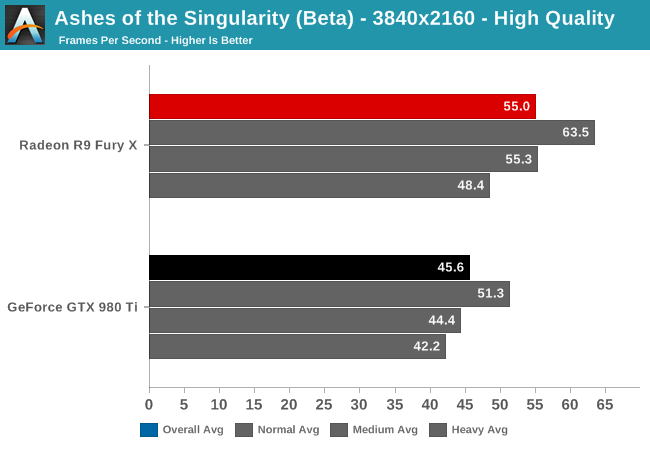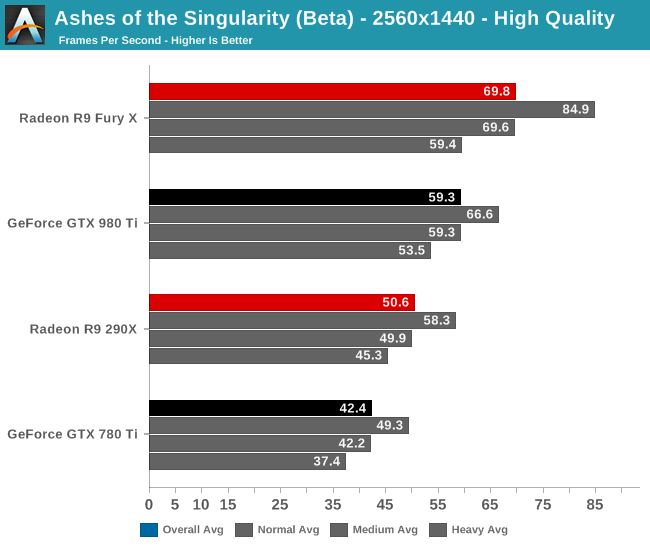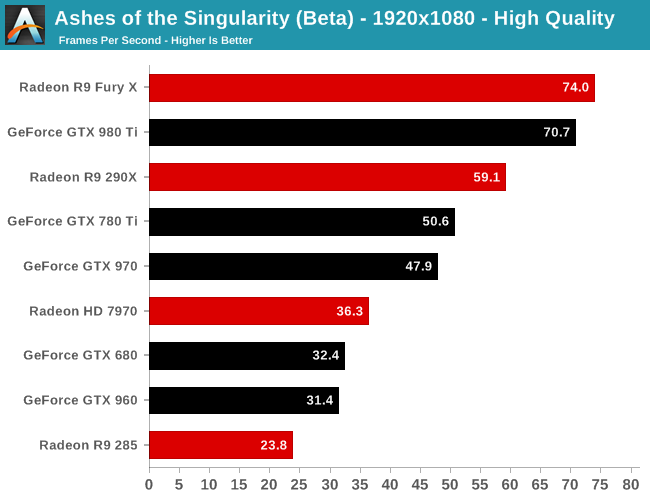Ashes of the Singularity Revisited: A Beta Look at DirectX 12 & Asynchronous Shading
by Daniel Williams & Ryan Smith on February 24, 2016 1:00 PM ESTDirectX 12 Single-GPU Performance
We’ll start things off with a look at single-GPU performance. For this, we’ve grabbed a collection of RTG and NVIDIA GPUs covering the entire DX12 generation, from GCN 1.0 and Kepler to GCN 1.2 and Maxwell. This will give us a good idea of how the game performs both across a wide span of GPU performance levels, and how (if at all) the various GPU generational changes play a role.
Meanwhile unless otherwise noted, we’re using Ashes’ High quality setting, which turns up a number of graphical features and also utilizes 2x MSAA. It’s also worth mentioning that while Ashes does allow async shading to be turned off and on, this option is on by default unless turned off in the game’s INI file.

Starting at 4K, we have the GeForce GTX 980 Ti and Radeon R9 Fury X. On the latest beta the Fury X has a strong lead over the normally faster GTX 980 Ti, beating it by 20% and coming close to hitting 60fps.

When we drop down to 1440p and introduce last-generation’s flagship video cards, the GeForce GTX 780 Ti and Radeon R9 290X, the story is much the same. The Fury X continues to hold a 10fps lead over the GTX 980 Ti, giving it an 18% lead. Similarly, the R9 290X has an 8fps lead over the 780 Ti, translating into a 19% performance lead. This is a significant turnabout from where we normally see these cards, as 780 Ti traditionally holds a lead over the 290X.
Meanwhile looking at the average framerates with different batch count intensities, there admittedly isn’t much remarkable here. All cards take roughly the same performance hit with increasingly larger batch counts.

Finally at 1080p, with our full lineup of cards we can see that RTG’s lead in this latest beta is nearly absolute. The 2012 flagship battle between the 7970 and the GTX 680 puts the 7970 in the lead by 12%, or just shy of 4fps. Elsewhere the GTX 980 Ti does close on the Fury X, but RTG’s current-gen flagship remains in the lead.
The one outlier here is the Radeon R9 285, which is the only 2GB RTG card in our collection. At this point we suspect it’s VRAM limited, but it would require further investigation.










153 Comments
View All Comments
Koenig168 - Wednesday, February 24, 2016 - link
There is a brief mention of GTX 680 2GB "CPU memory limitations". I take it you mean "VRAM memory limitations". It would be interesting to know if this can be overcome by DX12 memory stacking, either a pair of GTX 680s or the GTX 690.Ryan Smith - Wednesday, February 24, 2016 - link
That was meant to be "GPU memory limitations", thanks for the catch.B3an - Wednesday, February 24, 2016 - link
Why is Beta 2 still not available on Steam? Have the media got early access? At the time of posting this there's still only Beta 1 available.Ryan Smith - Wednesday, February 24, 2016 - link
It's out to the public tomorrow.hemipepsis5p - Wednesday, February 24, 2016 - link
Hey, so I'm confused by the mixed GPU testing. I thought that both cards had to be the same in order to run them in SLI/Crossfire? How did they test a Fury X + 980Ti?Ext3h - Wednesday, February 24, 2016 - link
That's no longer the case with DX12. It used to be like this with DX11 and earlier versions, when the driver decided if/how to split the workload onto multiple GPUs, but with DX12 that choice is now up to the application.So if the developer chooses to support asymmetric configurations, even cross vendor or exotic combinations like Intel IGP + AMD dGPU, then it can be made to work.
anubis44 - Thursday, February 25, 2016 - link
I'm willing to bet that nVidia's Maxwell cards can't use DX12's async compute at all, and they're falling back to the DX11 code path, even when you 'enable' DX12 for them.Ext3h - Thursday, February 25, 2016 - link
You loose that bet.The asynchronous compute term only defines how tasks are synchronized against each other, whereby the "asynchronous" term only states tasks won't block while waiting for each other. The default of doing that in software, in order to create a sequential schedule, is perfectly legit and fulfills the specification in whole.
Hardware support isn't required for this feature at all, even though you *can* optionally use hardware to perform much better than the software solution. Parallel execution does require hardware support and can bring an huge performance boost, but "asynchronous compute" does not specify that parallel execution would be required.
BradGrenz - Thursday, February 25, 2016 - link
The whole point of async compute is to take advantage of parallel execution. It doesn't matter what nVidia's drivers tell an application, if it accepts these commands but is forced to reorder them for serial execution because the hardware can do nothing else then it doesn't really support the technology at all. It's be like claiming support for texture compression even though your driver has to decompress every texture to an uncompressed format before the GPU can read it. It doesn't matter if the application thinks compressed textures are being used if the hardware actually provides none of the benefits the technology intended (in this case more/larger textures in a given amount of VRAM, and in the case of async compute, more efficient utilization of shader ALUs).Sajin - Thursday, February 25, 2016 - link
"Update 02/24: NVIDIA sent a note over this afternoon letting us know that asynchornous shading is not enabled in their current drivers, hence the performance we are seeing here. Unfortunately they are not providing an ETA for when this feature will be enabled."Source: http://www.anandtech.com/show/10067/ashes-of-the-s...